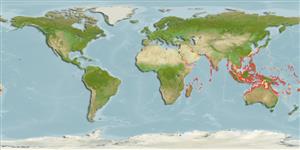Common names from other countries
Environment: milieu / climate zone / depth range / distribution range
Écologie
Récifal; profondeur 3 - 35 m (Ref. 8294). Tropical; 35°N - 34°S, 27°E - 175°W (Ref. 846)
Indo-Pacific.
Length at first maturity / Taille / Poids / Âge
Maturity: Lm ? range ? - ? cm Max length : 25.0 cm BRW mâle / non sexé; (Ref. 269)
Description synthétique
Morphologie
This hispidose branching coral forms colonies up to several meters in diameter and is common from shallow to intermediate depths throughout its range. It has stout branches up to 25 cm thick that appear "knobby" on the surface due to secondary branchlets of even height (Ref. 269).
Life cycle and mating behavior
Maturité | Reproduction | Frai | Œufs | Fécondité | Larves
Hermaphroditic (Ref. 113712). Mature gametes are shed into the coelenteron and spawned through the mouth. Life cycle: The zygote develops into a planktonic planula larva. Metamorphosis begins with early morphogenesis of tentacles, septa and pharynx before larval settlement on the aboral end (Ref. 833).
Hodgson, G. 1998. (Ref. 269)
Statut dans la liste rouge de l'IUCN (Ref. 130435: Version 2024-1)
statut CITES (Ref. 108899)
Not Evaluated
Utilisations par l'homme
| FishSource |
Outils
Sources Internet
Estimates based on models
Preferred temperature
(Ref.
115969): 24.6 - 28.8, mean 27.6 (based on 470 cells).
Vulnérabilité
Low vulnerability (15 of 100).
Catégorie de prix
Unknown.
